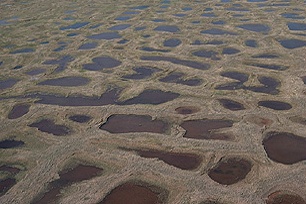
A major concern about rising temperatures in the artic and subartcic regions is the possible effect on methane released from perennial frozen soils and peat material.
In theory biological and chemical decomposition of organic material under cold temperatures is very slow or inhibit completely – so that in millennia’s vast amounts of carcasses, peaty material and detritus has accumulated. Rising temperatures can increase decomposition, releasing the greenhouse gas Methane, that itself contributes to the global warming.
A research conducted Torben Christiansen and his research team of the University of Lund (Sweden) now has discovered that even frozen soil of the arctic tundra can release methane.They studied for two winter months an area in the northeast of Greenland, and compared the data with measurements taken during the summer.
After the soil freeze in autumn there is an increase of methane in the air, with similar values during the summer – an observation that now can explain the measurements of high concentrations of methane in the artic by American scientists.The team thinks that the methane is primary produced by the microbiological activity in the active layer of the soil, then during autumn the soils freeze from up to down, squeezing the gas between holes, roots and other “tunnels” out from the underground. The total amount of annual released gas is estimated by 30 to 100 million tons of gas, in the autumn probably 4 million of tons are released.
MASTEPANOV et al. (2008): Large tundra methane burst during onset of freezing. Nature 456: 628-630





Keine Kommentare:
Kommentar veröffentlichen